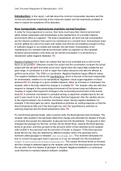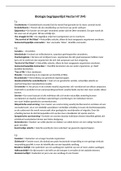Unit 9 Human Regulation & Reproduction: LA B
Introduction: In this report, I will talk about the common homeostatic disorders and the
normal and abnormal functioning of the endocrine system and the treatments available to
treat or reduce the symptoms of the disorders.
How homeostatic mechanisms maintain normal function-
In order for living organisms to survive, their body must keep their internal environment
within certain parameters and homeostasis is the maintenance of a constant internal
environment within an organism. The body’s temperature, pH level and salt concentration
are the internal conditions that need to be maintained at a constant level. Homeostasis stops
us from getting too cold or too warm and makes sure that we are breathing enough to bring
in sufficient oxygen in our bodies and maintain the salt levels. Homeostasis is the
maintenance of a constant internal environment within an organism so the important
functions and processes in the body can be carried out properly. It is achieved by a
mechanism called negative feedback. P2
Negative feedback has a factor (an output) that has to be controlled and a norm for the
factor (a set point)P2. Detectors monitor the output and the coordinators compare the actual
output with the set point and send out an error signal when the output falls outside the set
point range. A coordinator is a cell or organ that makes decisions and tells the effector to
perform some action. The CNS is a coordinator. Negative feedback keeps different values.
The negative feedback involves the hypothalamus, which is the part of the brain responsible
for homeostasis, whether it is for temperature regulation, blood sugar regulation or blood
pressure P2. If a change on a given variable happens, either an increase or a decrease, the
receptor cells in the body detect the change in a variable P2. The receptor cells are cells that
respond to changes in the surrounding environment of the human body and effectors are
muscles or organs that respond to changes in the surrounding environment of the human
body P2. A correction mechanism is activated aiming to adjust the variable back to the set
point it was meant to be to reverse the change that has happened. Ater the variable returns
to the original setpoint, the correction mechanism stops. During negative feedback, for
example, if the blood gets too warm, hypothalamus switches on cooling response so that the
blood temperature falls and if the blood gets too cold, the hypothalamus switches on
warming response and the blood temperature rises. P2
To control blood glucose levels, when a person eats, the blood glucose level increases. The
receptor cells located in the pancreas detect this change and stimulate the release of insulin,
a hormone that causes the absorption of glucose from the bloodstream. The glucose is then
changed into glycogen by the liver, so they can be stored there, causing the blood glucose
levels to go down until they go back to the set point which is then detected by the receptor
cells located in the pancreas and the secretion of insulin is stopped. “If the blood glucose
levels fall too low, they are detected by different receptor cells in the pancreas and a
hormone called glucagon is released” (Clark, Choi and Douglas, 2021). “This hormone stimulates the
liver to convert the glycogen back to glucose so it can be released into the bloodstream”
(Glucagon | You and Your Hormones from the Society for Endocrinology, 2021) . This causes the blood levels to increase
and this change is detected again by the receptor cells and if the blood glucose levels reach
the set point, then the release of glucagon is stopped. Negative feedback is a continuous
cycle that tries to maintain balance between variables.
1
, Unit 9 Human Regulation & Reproduction: LA B
Figure 01
Positive feedback is another mechanism that does not result in homeostasis but can be
useful in other situations. Positive feedback can be harmful because it can cause unstable
conditions. Instead of getting responses to some variables, in positive feedback, when a
change occurs in the body, the effectors amplify the charge further away than normal,
meaning that the variables intensify. For example, during childbirth, the pituitary gland
releases hormone oxytocin, then, oxytocin travels in blood to uterine tissue. After that, the
muscle in the uterus wall contracts more forcefully then, the cervix stretches and dilates,
making the nerve impulse sent to hypothalamus and the pituitary gland releases hormone
oxytocin again. Positive feedback increases the release of oxytocin, which will increase the
number of contractions and pressure which will then cause more release of oxytocin. P2
Figure 02
The role of hormones in the homeostatic mechanisms
Hormones are messengers that are secreted by glands. They enable more than one tissue
to be targeted because hormones are carried out of the body in the bloodstream. They also
enable long-term changes to be brought about, e.g. puberty. After a hormone enters into the
blood, it is carried around with it until it reaches its target location or organ. The cells of these
target organs have specific receptor molecules located on the surface of the membranes
that are attached to the hormone molecules, this produces a response by the changing of
the membrane.
Glands and hormones
Endocrine glands are the glands that secrete hormones into the bloodstream and these
glands make up the endocrine system. The main endocrine glands in the body are the
kidneys, hypothalamus, pituitary, parathyroid glands, adrenal glands, ovaries, testes, thyroid
2





